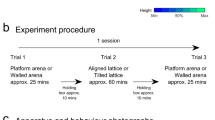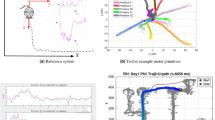Abstract.
A simple analytical model is proposed here that captures to a large extent the kinematic structure of rat exploratory behavior. Previous studies have shown that such behavior consists of regular excursions into the environment from a preferred place termed a home base. In the first part of this study, we showed that with time and repeated exposure to the same large environment, there is a gradual increase in the length of excursions. Concurrently, the rat's velocity pattern changes in a complex yet structured way, which is correlated with the exposure (=familiarity) to places. In this part, we show that the complex pattern described there might be explained by an analytic model, in terms of a simple dynamical system, with few assumptions concerning motivation and learning. The model is studied both by analysis and simulation. The theoretical examination of the dynamics of excursion length suggests that excursion length increases as a linear function of two system parameters, one governing the rate of motivation loss, and the other the rate of (location-specific) familiarization. Combining this theoretical finding with the empirical results suggests that the two theoretical parameters are linearly related: the less confident the rat, the slower its familiarization rate, and thus differences in patterns of movement between rats can be explained using one rat-specific parameter. Furthermore, the more complex velocity pattern of the rat can then be easily captured by the same model. The analyzed behavior of the rat suggests that the locale sensory information that the rat collects has a gradient towards the home base, with decreasing information input away from home base. This sensory pattern emerges from the simple set of rules and restrictions on the rat's exploratory behavior. Thus, instead of imposing a set of ad hoc restrictions on a simulated rat so that its spatial learning is similar to that of a real rat, the model suggests a set of simple intrinsic constraints to govern the exploratory behavior.
Similar content being viewed by others
Author information
Authors and Affiliations
Additional information
Received: 16 August 1996 / Accepted in revised form: 20 March 1998
Rights and permissions
About this article
Cite this article
Tchernichovski, O., Benjamini, Y. The dynamics of long term exploration in the rat . Biol Cybern 78, 433–440 (1998). https://doi.org/10.1007/s004220050447
Issue Date:
DOI: https://doi.org/10.1007/s004220050447




